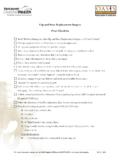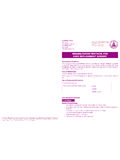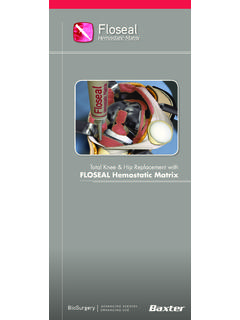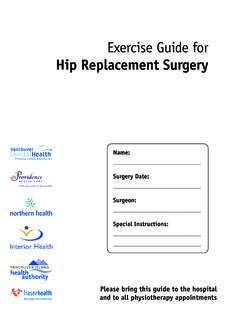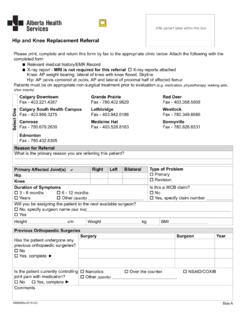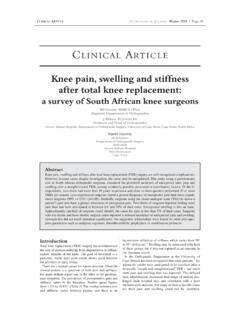Transcription of Your Practice On ine - hips & knees
1 Information is an educational resource only and should not be used to make a decision on knee replacement or arthritis management. All decisions about knee replacement and management of arthritis must be made in conjunction with your surgeon or a licensed healthcare Practice OnlineTOTAL knee REPLACEMENTPRESENTSM ultimedia Health Education your Practice On Prem Box No. 635 Sydney NSW-2001 Phone: +61-2-8205 7549 Fax: +61-2- 9398 3818 Email: USAH olly Edmonds RN, CLNC1006 Triple Crown Drive Indian Trail, NC 28079 Office: ( Toll Free)Fax: E-mail: New ZealandGreg EdenP O Box 17 340 Greenlane Auckland 1130 Phone: +64-9-636 1118 Fax: +64-9-634 6282 E-mail: MULTIMEDIA HEALTH EDUCATION MANUAL TABLE OF CONTENTS PA G E CONTENTSECTIONSN ormal KneeKnee Anatomy Arthritic knee REPLACEMENTM ultimedia Health Education your Practice On ine478129 knee ReplacementSurgical ProcedureRisks & knee is essentially made up of four bones.
2 The femur or thighbone is the bone connecting the hip to the knee . The tibia or shinbone connects the knee to the ankle. The patella (kneecap) is the small bone in front of the knee and rides on the knee joint as the knee bends. The fibula is a shorter and thinner bone running parallel to the tibia on its outside. The joint acts like a hinge but with some knee is a synovial joint, which means it is lined by synovium. The synovium produces fluid lubricating and nourishing the inside of the joint. Articular cartilage is the smooth surfaces at the end of the femur and tibia. It is the damage to this surface which causes arthritis. your Practice OnlineMultimedia Health Education your Practice On knee femur (thighbone) is the largest and the strongest bone in the body. It is the weight bearing bone of the thigh. It provides attachment to most of the muscles of the knee .
3 (Refer fig. 1) CondyleThe two femoral condyles make up for the rounded end of the femur. Its smooth articular surface allows the femur to move easily over the tibial (shinbone) meniscus. (Refer fig. 2) TibiaThe tibia (shinbone), the second largest bone in the body, is the weight bearing bone of the leg. The menisci incompletely cover the superior surface of the tibia where it articulates with the femur. The menisci act as shock absorbers, protecting the articular surface of the tibia as well as assisting in rotation of the knee . (Refer fig. 3) knee AnatomyNORMAL knees ection: 1 Multimedia Health Education your Practice On knee REPLACEMENTC ondyle(Fig. 1)(Fig. 2)(Fig. 3) Femur Tibia FibulaThe fibula, although not a weight bearing bone, provides attachment sites for the Lateral collateral ligaments (LCL) and the biceps femoris tendon. The articulation of the tibia and fibula also allows a slight degree of movement, providing an element of flexibility in response to the actions of muscles attaching to the fibula.
4 (Refer fig. 4) PatellaThe patella (kneecap), attached to the quadriceps tendon above and the patellar ligament below, rests against the anterior articular surface of the lower end of the femur and protects the knee joint. The patella acts as a fulcrum for the quadriceps by holding the quadriceps tendon off the lower end of the femur.(Refer fig. 5) NORMAL knees ection: 1 Health Education your Practice On knee REPLACEMENTF ibulaPatella (Fig. 4)(Fig. 5) knees ection: 1 Health Education your Practice On ineTOTAL knee REPLACEMENTM enisciThe medial and the lateral meniscus are thin C-shaped layers of fibrocartilage, incompletely covering the surface of the tibia where it articulates with the femur. The majority of the meniscus has no blood supply and for that reason, when damaged, the meniscus is unable to undergo the normal healing process that occurs in the rest of the body. In addition, a meniscus begins to deteriorate with age, often developing degenerative tears.
5 Typically, when the meniscus is damaged, the torn pieces begin to move in an abnormal fashion inside the menisci act as shock absorbers protecting the articular surface of the tibia as well as assisting in rotation of the knee . As secondary stabilizers, the intact menisci interact with the stabilizing function of the ligaments and are most effective when the surrounding ligaments are intact. (Refer fig. 6) (Fig. 6) knees ection: 2 Multimedia Health Education your Practice On ineTOTAL knee REPLACEMENTa. Arthritis Arthritis is a general term covering numerous conditions where the joint surface or cartilage wears out. The joint surface is covered by a smooth articular surface that allows pain free movement in the joint. This surface can wear out for a number of reasons; often the definite cause is not known. When the articular cartilage wears out the bone ends rub on one another and cause pain. There are numerous conditions that can cause arthritis and often the exact cause is never known.
6 In general, but not always, it affects people as they get older (Osteoarthritis).Other causes include Trauma (fracture) Increased stress , overuse, overweight, etc. Infection Connective tissue disorders Inactive lifestyle- Obesity (overweight); your weight is the single most important link between diet and arthritis as being overweight puts an additional burden on your hips, knees , ankles and feet. Inflammation (Rheumatoid arthritis)Now compare a normal knee with an arthritic the arthritic knee there is an absent joint space. In the normal knee there is a normal joint space. (Refer fig. 7 and 8) Absent joint spaceNormal joint space(Fig. 7)(Fig. 8) Arthritic KneeNormal KneeSection: 2/contMultimedia Health Education your Practice On knee REPLACEMENTb. In an arthritic knee The cartilage lining is thinner than normal or completely absent.
7 The degree of cartilage damage and inflammation varies with the type and stage of arthritis. The capsule of the arthritic knee is swollen. The joint space is narrowed and irregular in outline; this can be seen in an X-ray image. Bone spurs or excessive bone can also build up around the edges of the combinations of these factors make the arthritic knee stiff and limit activities due to pain or fatigue. (Refer fig. 9 and 10) c. Diagnosis The diagnosis of osteoarthritis is made on history, physical examination& X-rays. There is no blood test to diagnose Osteoarthritis (wear & tear arthritis).ARTHRITIC knee Normal KneeArthritic knee (Fig. 9)(Fig. 10)Multimedia Health Education your Practice On inea. Surgical procedureSurgery is performed under sterile conditions in the operating theatre under spinal or general anesthesia.
8 You will be lying on your back and a tourniquet applied to your upper thigh to reduce blood loss. The surgeon makes an incision along the affected knee exposing the knee joint. (Refer fig. 11) The surgeon first concentrates on the femur (thighbone). The damaged portions of the femur are then cut at the appropriate angles using specialized jigs. (Refer fig. 12 and 13) The femoral component is attached to the end of the femur with or without bone cement. (Refer fig. 14) knee REPLACEMENTS ection: 3 TOTAL knee replacement (Fig. 11)(Fig. 12)(Fig. 13)Section: 3 Health Education your Practice On knee REPLACEMENTTOTAL knee replacement The damaged area of the tibia (shinbone) and the cartilage are cut or shaved. This removes the deformed part of the bone and bony growth, as well as allows for a smooth surface for which to attach the implants.
9 (Refer fig. 15 and 16) The tibial component is secured to the end of the bone with bone cement or screws depending on a number of factors and on surgeons choice. (Refer fig. 17) The surgeon will place a plastic piece called an articular surface between the implants to assure a smooth gliding movement. This plastic insert will support the body's weight and allow the femur to move over the tibia similar to the original cartilage (meniscus).(Refer fig. 18) The femur and the tibia with the new components are put together to form the new knee joint. (Refer fig. 19) FemoralComponent(Fig. 14)(Fig. 15)(Fig. 16) : 3 Health Education your Practice On ine To make sure the patella ( knee cap) glides smoothly over the new artificial knee , its rear surface is prepared to receive a plastic component.
10 With all the new components the knee joint is tested through its range of motion. All excess cement will be removed. The entire joint will be irrigated or cleaned with a sterile saline solution. The knee is then carefully closed and drains usually inserted and the knee dressed and bandaged. TOTAL knee REPLACEMENTTOTAL knee replacement TibialComponent ArticularSurface(Fig. 17)(Fig. 18)(Fig. 19)Section: 3 Health Education your Practice On ineb. Risks and complications As with any major surgery there are potential risks involved. The decision to proceed with the surgery is made because the advantages of surgery outweigh the potential disadvantages. It is important that you are informed of these risks before the surgery takes place. Complications can be medical (general) or local complications specific to the complications include those of the anesthetic and your general well being.



